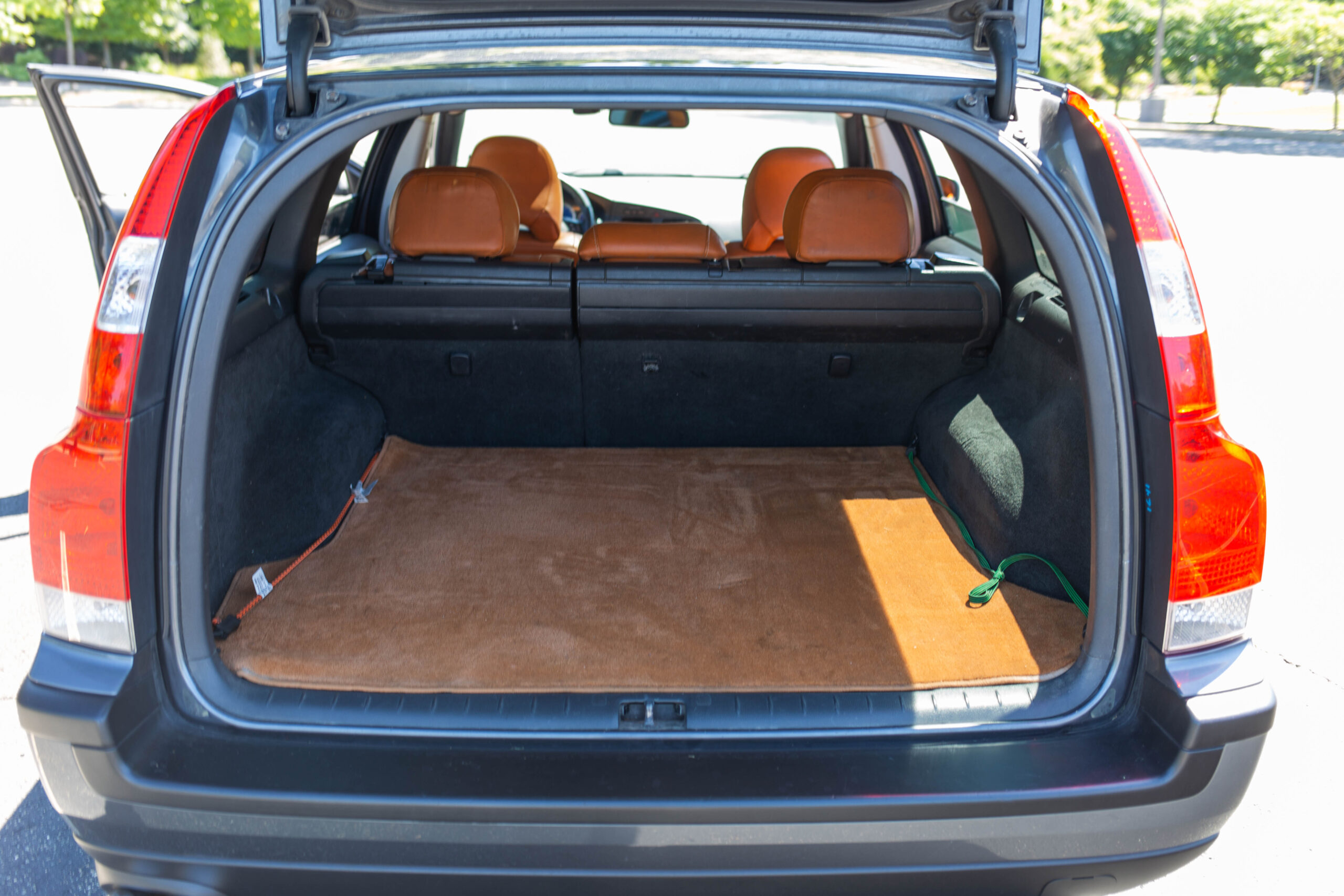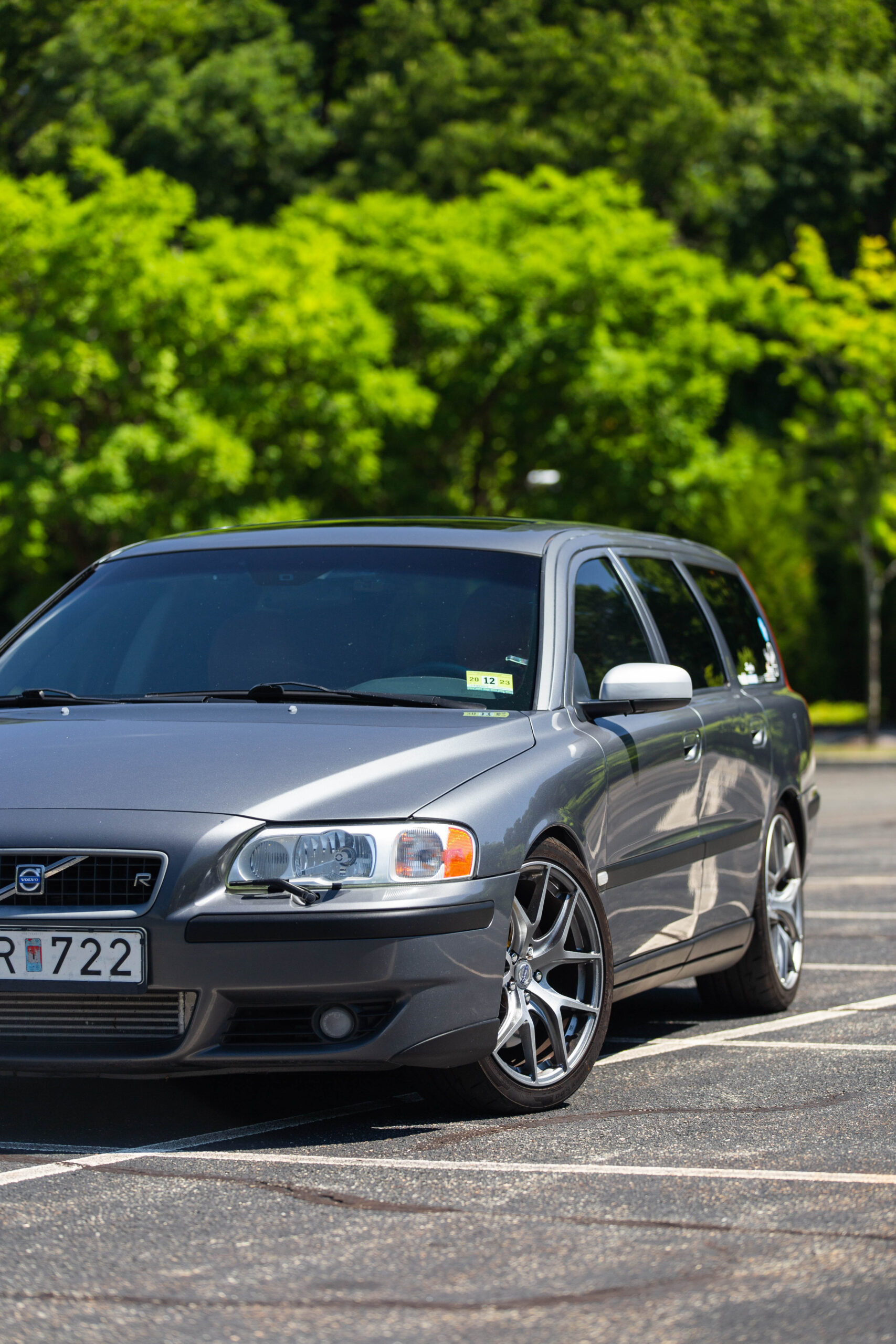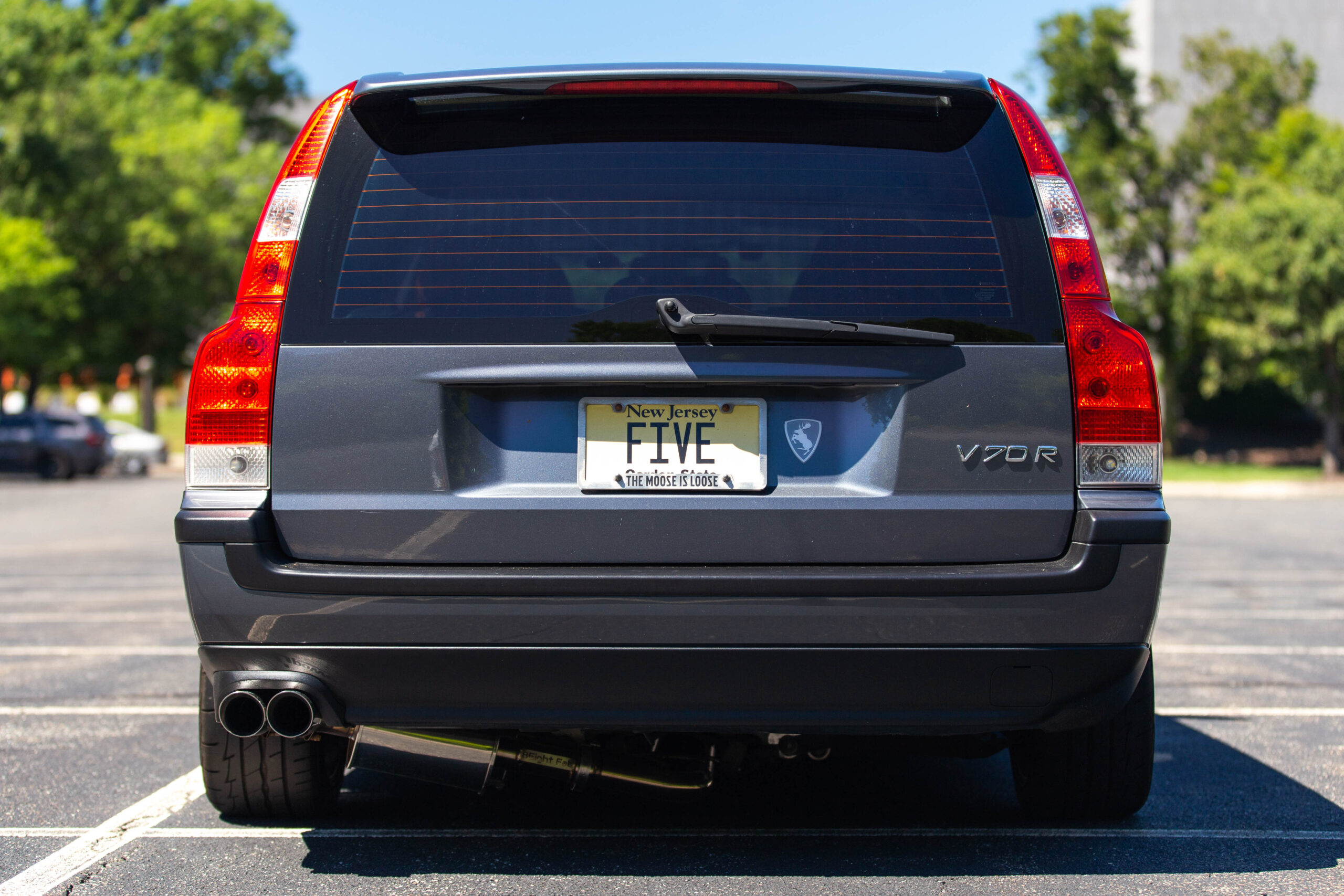As with any good sleeper, looking at this gray 2004 Volvo V70 R does not give you any funny ideas about track days at Watkins Glen or Palmer Motorsports Park, or of gapping Subaru boys in their WRX STIs fitted with giant front mounts and external wastegates.
But after extensive modifications (“It’d be easier if you asked me what I didn’t touch!”), that’s precisely what owner Aaron Segal has done in it. In addition to seeing track time, the V70 R’s been driven cross-country—visiting 27 of our 50 states—and mobbed up and down Southern California’s best roads. Whoever said you can’t have it all clearly hasn’t met the right car.

After an afternoon spent with it, I do believe Segal’s V70 R is the bitchin’-est wagon there ever was.
2004 Modified Volvo V70 R Review Specs
- Price when new: $41,635
- Powertrain: 2.4-liter turbocharged inline-five | 6-speed manual | all-wheel drive
- Horsepower: 375 crank | 320 wheel
- Torque: 405 lb-ft crank | 345 lb-ft wheel
- Seating capacity: 5
- Quick take: This modified V70 R looks at your M3 and laughs in five-cylinder fury.
Best Two Out of Three
Overall, Volvo made three generations of the V70, but only the first and second generations saw R versions of the wagon. Stock, the second-gen V70 R came with a turbocharged 2.5-liter five-cylinder engine that produced a claimed 300 horsepower and 295 pounds-feet of torque. All-wheel drive was standard, as was a six-speed manual, but you could option the car with a five-speed auto if you wanted.

There was a sedan version, too, in the form of the S60 R. Also a very good car.
The Mods
“If you know, you know” essentially defines everything about Segal’s V70 R. The gray exterior paint basically repels attention, yet the car’s cleanly handsome, mid-aughts lines have aged gracefully these 18 years later. The only real flashiness it wears on the outside are the yellow brake calipers and the sparkly Fastco flow-form wheels. (The taillights are the facelifted ones and there’s also underglow.) Below the surface? That’s another story.
The original 2.5-liter stock motor was swapped out in favor of a tuned 2.4-liter turbocharged inline-five from an S60 T5 because the 2.5s “tend to crack blocks when you throw boost at them,” according to Segal. Decreasing the bore just by 0.1 liters did away with the issue. (One wonders why Volvo didn’t just sell subsequent V70 Rs with the stronger 2.4-liter engine instead of the 2.5, but you know what happens when you cut peoples’ beloved displacement. There is no replacement.)





Then, there is the intercooler, intake, and short-throw shifter from Snabb—a popular Volvo aftermarket parts company made up of a couple of dudes in a barn in upstate New York. There’s a lightweight flywheel and a high-pressure fuel pump from DeatschWerks. The car’s power and response have been tuned to change with the suspension settings, too.
Exhaust mods include a downpipe and brand-new, prototype catback from 8Eight Fab, which is based in North Carolina. The entire car’s been lowered on Elevate lowering springs (Segal has plans to change these out soon) and there’s also an Elevate rear sway bar. Delrin and poly bushings round out the ride.
The cabin’s been treated to a full interior swap (which took just one night) from tan to the saddle-colored leather you see now. To do this, Segal bought a whole new car—a one-owner, locally found, 300,000-mile example. The only other addition is the aftermarket head unit.





All told, it’s a pretty sweet ride.
Burble Burble Burble
All of the V70 R’s ingredients—manual, wagon, five-cylinder, all-wheel drive—make it a car nerd’s darling. But whereas a brown, manual, diesel wagon is now probably more of a punchline than something to aspire to, I am legitimately jealous that this is Segal’s daily driver.
It’s certainly not a car with the most forgiving clutch in the world, as it’s a bit numb, springy on the depress, and grabs high. The shifter, too, feels a little rubbery while slotting into the gates. But these are small quibbles you get used to and are a very affordable tradeoff when you get into the power.




With a V10’s blustery, burbly, and Lamborghini-ish scream, acceleration in the V70 R has it cascading forward like it’s riding a wave, surfing on the telltale, elasticky-feeling of all-wheel drive and turbo spool-up. You really get into the powerband past 4,000 rpm, where it feels like something colossal somewhere opens up and wallops you even more urgently onward like you’ve been smacked hindside by a cricket bat. Shifting quickly means there’s a little rev-hang to get used to—but again, this feels like a feature, not a flaw. The whole experience is tied off neatly with the turbocharger’s gratifying whoosh.
The V70 Rs never pretended to be sports cars, and despite Segal’s extensive modifications, his doesn’t handle like one, either. That was not the point. Push the wagon a bit in the corners and you can feel the character seams in the performance: the extra mass behind the driver’s seat that wants to swing out like a shot during a shot put, the looser handling that’s just slightly anesthetized off-center. Those Brembos are real strong, though.
There’s good feedback coming up through the wheels, but the ride isn’t punishingly damped. You can tell what sort of road you’re on, but the bumpier bits certainly aren’t distracting. What is distracting is the car’s abysmal turning radius; it was like trying to navigate a school bus.


The fun part is messing with the suspension settings, which, as mentioned above, are not only connected to the car’s throttle response, but to its exhaust as well. Specifically, to its burble tune. Tap the Advanced button, the ride tightens up, and a series of cracks and bangs sound out when you let off the throttle. Is it obnoxious? Absolutely. But it was also goddamn fun, my reputation be damned. I daresay turning gasoline into noise is a favorite pastime of most of ours, and if I get the opportunity to do it in a five-cylinder, you best bet I won’t be turning it down. Would you turn down the chance to ride a unicorn? I didn’t think so.
I’ve driven a few sleepers in my day, but none of them hid quite as well in plain sight as this modified V70 R. It was like mobbing around in a gray automotive equivalent of a ghillie suit. It’s not particularly loud if you have it in its quieter modes, and if you do drive it as a commuter does, it hides its power extremely well. It is a Volvo station wagon, for crying out loud. Perhaps the only thing that gives it away from the outside is Segal’s impressive sticker collection.
The R Way
This is normally the part where I’d bellyache about how Volvo should bring R back—like, real R, not that watered-down R-Design weaksauce it devolved into. But I don’t see it happening. Today’s Volvo is about refined luxury, and it seems like anything hoonier than that will be some kind of Polestar instead. Which is still cool, let me be clear!



But even in the aughts heyday, the V70 R stood out as unique. Who else made a five-cylinder wagon with a manual and all-wheel drive? And with that tune-happy turbo, this was a modifier’s sleeper waiting to happen.
With that knowledge, it’s easy to go long. Easy to stack on the power and build a car that’s more powerful than sensible. Here, Segal admirably resisted the urge. The mods he’s added are tasteful—but most importantly, they do not inherently imbalance the car, nor do they seek to right the wrongs that give it the personality it has. They merely enhance what’s already there.
Drive this V70 R normally and you’d be none the wiser as to what lurks below the gray paint. Bury your foot a little harder, though, and you’ll give those AMG and M3 buyers a run for their money. This is the R way.


Got a tip? Holla at me: kristen@thedrive.com
